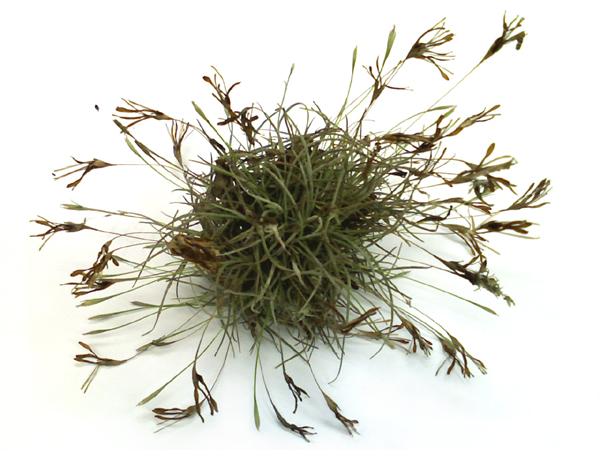Ball Moss - Just Hanging Out

What is ball moss?
Ball moss is a small epiphyte commonly found clinging to limbs of live oaks and other trees in southwest Texas. Ball moss is not a moss, but a true plant with flowers and seeds. It is a member of the bromeliad family, which also contains Spanish moss and pineapple. Epiphytes are plants that attach themselves to limbs, tree trunks, power lines, fences, and many other structures with pseudo-roots. Unlike true roots, they do not absorb water and minerals; they merely attach the plant to an aerial structure. Since epiphytes do not take nutrients and water from these aerial structures, they are not parasites; therefore, ball moss is not a parasite.

Tillandsia recurvata
Family: Bromeliaceae
(bro-mee-lee-AY-see-ee)
Genus: Tillandsia (til-LAND-see-uh)
Species: recurvata (rek-er-VAY-tuh)
Is it killing my tree?
If ball moss is not a parasite, then why does it seem that those branches covered with it are dying?There is a lot of controversy about this. If you take careful notice, you will observe the majority of these dead limbs are in the interior of the tree's canopy. Ball moss prefers an environment with low sunlight intensity and higher humidity. The interior canopy of trees (especially live oaks) provides an ideal environment for ball moss. These interior limbs die from a lack of sunlight, rather than from the ball moss plants colonizing these branches. If the tree is heavily covered with ball moss to the extent that the plants are covering the exterior of the canopy, then control is recommended. If it is a light to moderate infestation, control is not necessary for the health of the tree.
How do I control ball moss?
First of all, it is important to note if the other trees in the area are also colonized by ball moss. A tree that has been picked free of the plant can be quickly re-colonized if the neighboring trees are infested. Because of this, thoroughly controlling ball moss may require neighborly or community cooperative effort.
Ball moss can be controlled using three methods: picking, pruning or spraying. Each method alone may not provide adequate control. Using a combination of all three methods may result in the most thorough treatment.
Picking involves physically pulling each plant off the tree. This method can be very effective, but is extremely tedious and labor intensive. It can also be quite dangerous without the use of proper equipment. Please use caution and practice proper safety techniques if employing this method.
Pruning consists of removing the dead, interior limbs from the tree and/or lightly thinning the canopy. The majority of the ball moss is growing on the dead, interior limbs; therefore, by removing these limbs, you physically remove the majority of the ball moss. As mentioned above, ball moss prefers areas with low sunlight intensity. Light thinning of the canopy (only if necessary) allows more sunlight to reach the interior of the tree, discouraging future infestation. When pruning, always be sure to follow proper pruning techniques so as to not damage the tree.
Spraying can involve either applying a simple baking soda mix or a specific chemical to the tree in a foliar spray. Kocide 101 has been shown to provide adequate control. Do not exceed the recommended rates for this chemical, since higher concentrations can actually damage the tree. The ball moss will shrivel up and die in 5 to 7 days, but will remain in the tree until the wind or rain knocks it out. For this reason, it is recommended to prune out the deadwood first. In doing so, you will most likely remove the majority of the ball moss from the tree and practice good tree maintenance at the same time. Neither picking, pruning nor spraying will remove all of the ball moss from the tree, but these treatments can certainly help to control it.
Article submitted by Jason Traweek, Conservation Program Coordinator, City of Austin Tree Division in the Development Services Department.

This information is sponsored by the City of Austin. Learn more about trees and resources at the Tree Information Center!

